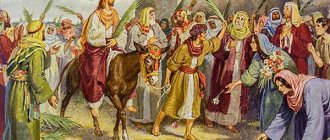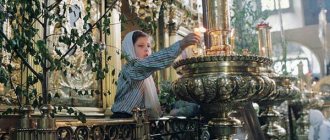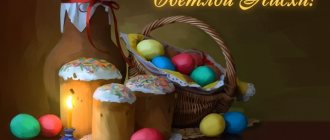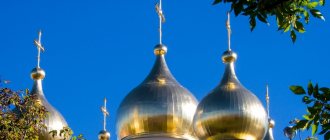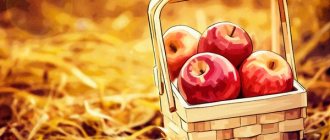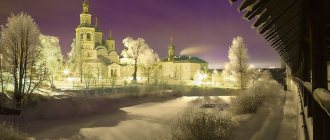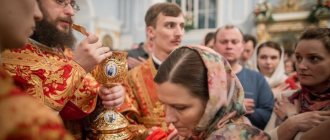Date in 2021: May 4, Tuesday.
Good Friday is considered the strictest and saddest day in the church calendar. In order to spend this important day according to traditions and not break the prohibitions, we suggest that you get acquainted with the church and folk rituals of Good Friday.
| When is it celebrated? | 2 days before Easter |
| Traditions | They take out the shroud and conduct a special service. They remember the torment and sacrifice of Jesus. Prohibition on eating, working, and entertainment. |
Each event on the church calendar has a sacred meaning, which is usually associated with historical events. It was these legends that formed the basis for certain actions that over time became traditions. Unfortunately, in the hustle and bustle of life, people forget about ancient rituals. And even on such an important day for Christians as Good Friday, few ordinary people will be able to remember the history of the holiday and the customs of how it is usually celebrated.
History of a sad day
The day before Easter falls on Friday of Holy Week. The story is directly related to the Resurrection of Jesus Christ. It was on this day that the crucifixion of the Son of God took place after an unjust condemnation.
Crucifixion of the Son of God
The Savior proudly endured all the bullying and humiliation and accepted death with dignity, despite the fact that he knew about his death in advance.
He accepted all the torment that befell him, even refusing the wine offered, which was supposed to ease the suffering. He took such a step because he knew that his mission was to save the souls of sinners.
And already at the Last Supper he informed his followers about his future fate. Therefore, those whose faith was true already on this day expected a miraculous resurrection.
Good Friday is a difficult day that carries a sacred meaning. He reminds believers of sins, of Christ’s sacrifice, of his burial. But at the same time, he prepares Christians for the resurrection of the Lord.
So the Easter holiday is closely connected with Good Friday - in 2019, what date is celebrated is easy to calculate. Good Friday falls on April 26th.
Pilate's Court
The Jewish priests, having seized Christ on Thursday, sentenced him to death, but it had to be approved by the Roman ruler Pontius Pilate. Pilate arrived in Jerusalem before Passover, which the Jews celebrated every year, remembering their liberation from Egyptian captivity. That year Easter fell on Sunday.
Bound and spat upon, Jesus was brought to Pontius Pilate, who asked Christ if He was a king, to which the Savior did not give a clear answer, but showed Himself to be a teacher, a preacher, but not a troublemaker. (Luke 15:1-7).
The Trial of Jesus Christ
Pilate did not find the Savior guilty and transferred the solution to the unpleasant issue for him to Herod, the king of Galilee.
Surprisingly, the procurator made his decision after a conversation with his wife, who asked not to do anything bad to the prisoner, because she had a dream that she suffered for the Teacher. The Bible does not give the name of this woman, but historians claim that she was Claudia Procula, who later converted to Christianity and was canonized.
Tetrarch Herod Antipas hated Christians, about whom he had already heard, and gave the Recusant to be mocked by the Roman soldiers. It is difficult to imagine what kind of torture the Son of God was subjected to, how God the Father cried when he saw the whips with huge hooks at the ends. The Holy Blood flowed like a river, but the warriors, insatiable by human suffering, continued their work in front of the numb crowd, joyful priests and grief-stricken Mother Mary.
Having violated the innocent Jesus, Herod sent the half-dead God-man back to Pilate to carry out his sentence. Pontius Pilate, not wanting to be recognized as an opponent of Caesar, confirmed the verdict, while uttering his famous phrase that there is no innocent Blood on his hands, all the blame now lies with the Jewish people, with future generations. (Matthew 27:24).
Pontius Pilate washes his hands of
Rules and traditions
On this day, believers always try to attend all three services. At morning, afternoon and evening services in church, priests read stories from the Gospel related to the life and death of the Savior.
Church service
All these stories are of great importance for Christians, as they carry a sacred meaning. The peculiarity of this day is emphasized by the absence of liturgy.
At the evening service, a canon is sung, which tells about the crucifixion of the Lord. The shroud is also brought out - a special cloth with the image of Jesus Christ, who is depicted in a full-length tomb.
The Shroud is taken out of the Temple, and, after going around the parishioners, it is returned to the church, where it is installed in the center on a raised platform. Everyone present is obliged to venerate the Shroud in gratitude for the sacrifice of Christ.
For all those who fast, the fast is intensified. You can't eat until three o'clock in the afternoon. It is forbidden to even drink water. Only in the evening you are allowed to try some bread.
Today, even people who do not fast refuse delicacies and delicacies. This tradition also left its mark on work related to cooking. It is not customary to cook anything on Good Friday.
Crucifixion of Jesus
The execution of Jesus was scheduled for Tuesday,
April 17,
29. Since Herod Antipas and Pontius Pilate refused to find Jesus guilty, they allowed Caiaphas to punish Jesus himself. A place was allocated for the execution in the city center. Two executioners were appointed to carry out the sentence: one tall, the other slightly shorter. The whips with which they beat Jesus had five tails of unequal length. Iron weights were attached to the end of each tail so that the lashes would grip the body more tightly and, when pulled from it, tear the skin. Before Jesus was sent on his way, he was beaten for a long time and a lot. First, they tied Jesus by his raised arms to a pole and began to lash him with whips, first on his back, then on his chest and stomach. Two of the crowd beat Jesus on the head with sticks, breaking the bridge of his nose. Jesus silently endured all the beatings, without uttering a sound. But all the executioners were simply exhausted. When, after this punishment, Jesus was clothed in a white shirt, it immediately turned into purple. They placed a crown of thorns on Jesus’ head and hung a sign around his neck: “I am God.” The inscription was made in four languages - Aramaic, Hebrew, Greek and Latin. The Jewish priests, seeing this inscription, began to be indignant. They wanted to execute Jesus as a blasphemer, as an impostor king, but not as God. No one doubted that there was some kind of divinity in Jesus. Anyone who saw Christ began to feel the incredible strength and energy emanating from him; a mystical awe covered everyone who felt it. Jesus silently endured all the beatings and bullying, confirming his teaching - God loves everyone, He cannot cause pain and suffering to anyone, not even his executioners. God doesn't punish anyone! The Jews rushed to Pilate, demanding to change this inscription to another: “I am the King of the Jews.” Pilate refused their request, saying: “What I wrote, I wrote. You accused him of being God. If he considers himself the king of the Jews, then this is not a sin. Judea can have many kings. You blame him for this. I don't blame him for this. I don’t want the blood of this righteous man on me.” The Bible says that on the tablet it was written: “Jesus of Nazareth - King of the Jews.” This is too large an inscription and it simply could not fit on a small tablet in four languages. The first to understand this were painters who tried to fit this inscription on their canvases; this inscription simply did not fit. Then a way out was found - on a small tablet on the cross there were simply four Latin letters - JNRJ, which stood for: Jesus Nazarenus Rex Judaeorum (Jesus of Nazareth - King of the Jews). It was simply pointless to write four letters that no one could understand on the sign. In fact, there was a short inscription: “I am God,” without any abbreviations. The Roman priests, rewriting the Bible in 325, tried to keep this fact silent. Jesus himself must bear his own cross, on which he was to suffer. The cross, made of oak, was very heavy. The height of the cross was 2.5 meters, width - 1.5 meters. Together with Jesus, they prepared two criminals for crucifixion, mockingly saying: “You are God, and these are your two angels, let them help you.” When the exhausted and physically exhausted Christ fell under the weight of his burden, then the executioners walking nearby beat him again with whips until he rose to his feet. Simeon, coming from the field, saw Jesus fall, breaking his knee into blood, and the heavy beam of the cross hit him on the back and legs. Then Simeon, not thinking about what would happen to him, rushed to the aid of Jesus. The soldiers accompanying the procession were already quite tired, and they were tired of trudging along with Jesus through the dusty and dirty streets of Jerusalem. Therefore, no one stopped Simeon, and Jesus walked alongside, sometimes lightly holding onto the cross. A large crowd accompanied Jesus to Calvary during the Way of the Cross. The overwhelming majority of these were people who did not believe in him and did not recognize his teachings, but went to see the execution out of curiosity. Among them were many who had previously wanted to walk with Jesus and whom he sent away, seeing their greed, cunning, envy and greed. Jesus did not keep such people near him, and they were offended and embittered because he rejected them. Ordinary Jews - farmers and cattle breeders, on the contrary, were very sad and worried about Jesus, but could not do anything. They feared for their lives, for their children, fear literally paralyzed their will. These people were not yet ripe for decisive action, they were not ready either for an uprising or for protecting anyone. During the Way of the Cross, one woman named Veronica wiped the tormented Jesus' face with a handkerchief. And on this piece of material the face of the Savior suddenly appeared.
The Face of Christ
Golgotha
is a skull-shaped hill in the vicinity of Jerusalem. In Hebrew, "Golgotha" means "skull." First, a cross was buried in the ground. A cabinet similar to a bench was placed next to the cross. To prevent the cross from swinging in different directions under the weight of the body, it was firmly nailed to this stand. The crucified man did not hang on the cross, but rested his feet on a wooden stand. At the same time, his legs were nailed to the pedestal so that he could not even move. This was done so that the executed person, while suffering longer, would retain strength and not die too early. Not all crucified people were sentenced to death. Some of them, after several days of torture, were taken down from the cross and released. The executed man's hands were nailed to the crossbar of the cross.
Icon “Crucifixion” The theme of the Crucifixion is so significant that Russian icon painters created several versions of it. The most ancient and short one was adopted from the Byzantines and embodied in the frescoes of the Church of Hagia Sophia in Kyiv in the 11th century. The frescoes depict Christ crucified on Golgotha, standing before him are the Mother of God and the young John the Theologian. Golgotha is presented in the form of slides, inside of which is the white skull of Adam, buried, according to legend, at the site of the crucifixion of Jesus Christ. The most complex and populous compositions of the Crucifixion appeared in the 17th century; they clearly represented the motifs of the Apocalypse: the Metvets rising from the grave and a solar eclipse in the form of a curling celestial scroll. The suffering of Christ also became visible.
Icon "Crucifixion"
The icon painters placed the warriors on the sides of the cross; one of the warriors pierced the sufferer’s body with a spear, the other brought him a sponge to inflame the wounds and arouse thirst; There were also soldiers here, dividing Christ’s clothes by lot. In addition to Mary and John, crying wives appear before the crucified Christ, as well as Longinus the centurion - he was the first who, looking at the torment of Christ, exclaimed: “Truly, he was the son of God.” There was another version of the Crucifixion - with robbers. At the same time as Jesus Christ, according to the Gospel, two more robbers were crucified; one of them, repenting of the evil he had done, believed in Christ as God, and for his faith after his death was accepted into heaven. Sometimes Russian icon painters depicted him separately, the icon was called “The Noble Robber Rakh”. Icon "The Prudent Robber"
Icon “The Noble Robber Rakh”
Four nails were driven into the body of Jesus Christ.
Two nails pierced his wrists, and two more nails pierced his legs. While the cross was being buried in the ground, Jesus addressed the people of Jerusalem: “Daughters of Jerusalem, take care of your children.” Do not let anger, envy, or cruelty settle in their souls. Be merciful to each other, forgive each other, love each other, and then God will dwell in the soul of each of you. I'm sorry for everything I once did for you. After the crucifixion, hellish pain pierced his entire body. Jesus clenched his teeth from tension, trying to turn off his consciousness, as he learned to do in distant India and from Tibetan monks. He managed to put himself into a sleep-like state and at least alleviate his torment a little. When the guards offered him a special pain-relieving drink made from vinegar and bile, which was given to all convicts to ease the suffering of those executed, he simply silently turned his head to the side. Jesus, crucified on the cross, wore only one loincloth. “One of them ran up, soaked a sponge in wine vinegar, put it on a stick and handed it to Jesus for him to drink.” Gospel of Mark. Shouts were heard from the crowd watching the execution: “He who destroys the temple and builds it in three days! Save yourself! If you are the Son of God, then come down from the cross!” The high priests with the scribes and elders and Pharisees mocked and said: “He saved others, but he cannot save himself. If he is the Son of God, let him now come down from the cross, and we will believe in him. Let God deliver him now, if he pleases him. He himself said: I am the Son of God.” The robbers crucified with him behaved differently. One of the hanged villains scolded Jesus and said: “If you are the Christ, save yourself and us. Because of you, we were crucified like your angels. We are suffering because of you." Another calmed him down and said: “Or are you not afraid of God, when you yourself are condemned to the same thing? And we were condemned justly, because we accepted what was worthy of our deeds, but he did nothing wrong.” A reminder of these two crucified with Jesus is the oblique lower crossbar on the cross of Orthodox Christians. The raised end seems to indicate the thief who praised Jesus, and the lowered end - the one who scolded him. Jesus was crucified on Tuesday at two o'clock in the afternoon, April 17, 29
. Early in the morning on the second day, the thieves were taken down from the cross and released. They served their sentence. Jesus remained hanging on the cross. The soldiers, taking pity on Jesus and touched by his courage, removed the crown of thorns from his head. And the women who came were allowed to give wine to the executed man. Jesus spent almost a week on the cross. Jesus instructed his beloved disciple John to take care of his mother long before the crucifixion. During the execution on Calvary, neither the Virgin Mary nor John was present. John, having learned about the exact day of Jesus’ execution, went to Nazareth to fetch Mary, deciding to come with her to Jerusalem on the second day after the execution. He found Mary excited, she told him that when she lay down to rest yesterday afternoon (Tuesday), she dreamed of Jesus - he called her and asked for help; when she woke up, she felt a terrible pain in her heart, which had not yet gone away. John did not say anything, explaining the reason for his coming by saying that Jesus wanted to see her in Jerusalem on Saturday. Maria immediately felt something was wrong; she could not find a place for herself either on the last day before the journey or on the road, she felt especially bad when there was only half a day left to Jerusalem.
When you achieve freedom, You can walk on water, You can swim through the air as if you were on water. For this - to suffer at trial, At the slave trial of the people... But is the torture cross scary, When freedom comes, When you are resurrected forever!
Great Wednesday of Holy Week
Wednesday of Holy Week is the day when the Church remembers Judas Iscariot's betrayal of his teacher Christ for 30 pieces of silver. In addition, on this day we remember the Gospel story about the sinner who washed the head of Jesus with peace. Holy Week - the seventh week of Lent - is entirely devoted to the memories of the suffering, death on the Cross and burial of Jesus Christ. According to the Gospel of Matthew, the Lord spent the night of Wednesday in Bethany (Matthew 26:6-17). Here, in one of the houses, a certain woman, whom the Evangelist calls a sinner, poured precious myrrh (a mixture of vegetable oils, fragrant herbs and resins) on Jesus’ head. Historically, anointing with myrrh in the East was used both when anointing kings and high priests, and in everyday life by rich and noble people. They usually anointed the hair on the head, forehead, face, beard, clothes and even feet. Knowing Christ’s dislike for luxury, his disciples became angry with the woman for a kind of “waste,” since the ointment could be sold for a lot of money, which was then distributed to the poor. At the same time, Christ himself not only accepted her gift, but also said: “Wherever this Gospel is preached in the whole world, it will be said in her memory about what she did.” Christ justified the action of the repentant sinner because he considered that it was dictated by faith and heartfelt contrition. This woman did not come to Jesus to receive physical healing - it was a desire to honor him and receive spiritual healing.
In addition, as Christ himself considered, through the libation of the ointment the repentant sinner seemed to have prepared Him for death and burial: “Having poured this ointment upon My body, make it for My burial.” So, the Church glorifies the woman’s act, while at the same time contrasting it with the betrayal of Judas, which was committed on the same day. So, in the church service of Great Wednesday, the “sinner” wife is glorified and the love of money and the betrayal of Judas is condemned. On Wednesday, as well as on Monday and Tuesday of Passion, the Liturgy of the Presanctified Gifts is celebrated - the last one during Lent. In addition, the prayer of St. Ephraim the Syrian “Lord and Master of my life” is read for the last time with three prostrations to the ground. From this moment, bowing to the ground stops until the holiday of the Trinity (with the exception of bowing before the Shroud). Also, Holy Wednesday is usually the day of confession for believers on the eve of Maundy Thursday. The fact is that on Passion Thursday, Orthodox Christians try to take communion - but not all parishioners can have time to confess on this day itself, so there is a big confession in churches the day before. The clergy note that for parishioners Wednesday evening is a unique opportunity to confess in more detail than on ordinary days, and urge them to take advantage of it.
Maundy (Clean) Thursday
On Thursday of Holy Week, the Church remembers the most important gospel event: the Last Supper, at which Christ established the New Testament sacrament of Holy Communion (Eucharist). Two days before the arrival of Christ in Jerusalem, the enemies of Jesus gathered, with them one of his twelve disciples - Judas; for thirty pieces of silver he promised to hand over the teacher. This happened on the eve of the Old Testament Easter - an ancient holiday in honor of the happy exodus of the Jews from Egypt. Jesus, as the evangelists testify, knew about the betrayal of Judas and decided to share the Passover meal, the last in his earthly life, with his disciples. This was the last Easter supper that the Lord could celebrate with His disciples in His earthly life.
Icon “Washing of the Feet” The theme of “Washing of the Feet” was sometimes depicted separately in icon painting.
Christ, in the interpretation of the icon painters, performed ablution or stood with a towel, thoughtfully, in front of Peter; Peter, with his legs bare to the knees, sat in a pose of reflection. St. Luke reports that at the supper there was a dispute between the disciples about which of them was older. Probably, this dispute was the reason for showing the disciples a clear example of humility and mutual love by washing the apostles’ feet. “There was a custom before supper to wash one’s feet, which the servant usually did. But this custom was not always observed (cf. Luke 7:44); apparently, it was not observed even in the small company of the Lord, obviously because the Lord Himself had in mind to show the disciples an example of humility and selfless love: “He showed by deed that, having loved those who were in the world, he loved them to the end.” See washbasin and towel. The apostles, as was customary on Easter, at the festive table tasted the meat of the Passover lamb, unleavened bread, bitter salad and wine. Unexpectedly for everyone, Jesus Christ said: “One of you will betray me,” and when asked who exactly, he answered: ... the one to whom I will dip a piece of bread,” and gave the bread to Judas. The apostles did not immediately understand what had happened, but Judas left the house under cover of darkness. After Judas fled, Christ, remaining with the disciples, broke bread, blessed it and distributed it to the disciples with the words: “Take, eat: this is my body,” then he took the cup, blessed and gave it to the disciples: “Drink from it, all of you, for this is my blood of the New Testament, which is poured out on many for the remission of sins.” Thus, according to legend, Christ himself showed what Christian worship should be like, gave rise to Christian Easter with the words: “Do this in remembrance of me,” and turned the festive meal into a farewell supper, reminiscent of the death of Jesus Christ.
Icon "Last Supper". The plot of the Last Supper was widespread in ancient Russian mural painting, and from the 15th century - in icon painting.
In accordance with the Gospel text, the icon painters arranged the meal participants around the table, but Christ can always be recognized: with his right hand he blesses the apostles, with his left he holds a rolled scroll. We also unmistakably recognize Judas; he reaches out to the cup. In the 17th century, the “Last Supper” was placed above the entrance to the altar; such compositions have an elongated shape. On the icons of that time you can see interesting details concerning Russian life. For example, it is known that in old Rus' they used knives at the table, and plates for meat replaced large slices of bread. This is exactly the “setting” that can be seen on icons of the 15th-17th centuries. The table of the 18th century meal looks completely different, filled with bowls, goblets and even forks, which back in the 17th century were only the privilege of the king and queen at the feast.
The events that took place during the Last Supper after the departure of Judas were embodied in the theme of the Eucharist. The word “Eucharist” literally means “grace” when translated from Greek. This is the name given to the rite of the sacrament of communion, performed during the liturgy - the most important part of Christian worship.
Icon “Eucharist” The iconography of the Eucharist spread widely in Rus' in pre-Mongol times, mainly in mural painting. Usually two repeating scenes were depicted: in one, Christ, standing at the throne, communes with bread, in the other, with wine. Bread and wine symbolized the body and blood of Christ, embodying the idea of sacrifice for the salvation of mankind.
On Thursday they clean the house, bake Easter cakes, and paint eggs. On Maundy Thursday, it is customary to get up before sunrise and take a bath - symbolically to cleanse yourself of sins and vanity... On Maundy Thursday, peasants cleaned the house, yard and garden of the rubbish, dirt and dust that had accumulated over the winter. First of all, icons and lamps were renewed and washed. Then they carefully washed the floors, walls, ceilings of the hut, the table and benches, scrubbed with sand, and scraped with a knife. People said: “If you wash and wash on Maundy Thursday, the hut will be clean all year round”... After the cleaning carried out on Maundy Thursday, the houses were not cleaned and the floors were not swept until Easter, so as not to “clog the eyes of Christ lying in the tomb.” " In some areas, on this day they washed all the dishes in the house, and milk jugs were also fumigated with women’s hair, explaining the importance of this activity by the fact that the dishes were desecrated by the touch of Judas the Traitor... On this day, a big wash was done - all clothes, bed linen, tablecloths, curtains and towels, as well as rugs, rugs and bedding. Everything was taken out to dry in the yard, and the whole family on the night from Thursday to Friday went to bed on “pea straw,” which was spread on the floor. In the Russian North, for example, mothers taught their daughters, and mothers-in-law taught their daughters-in-law: “Everything needs to be washed, even the little footcloth is happy about Easter”...
Russian icon.
Icon of the Mother of God “Weeping at the Cross”
This icon of the Mother of God is sometimes called “Simeon’s Prophecy” (the same as the icon “Softening Evil Hearts”) - from the words of Simeon the God-Receiver, when, predicting the fate of Jesus Christ, he turned to the Mother of God with the words: “... and a weapon will pierce your own soul "(Luke 2:35). This weapon (sword) is often depicted on the icon of the Mother of God pointed at the heart of the Blessed Virgin Mary. In addition to the cross, the icon of the Mother of God depicts in detail all the other instruments of the passions and objects that are in one way or another connected with the last days of Christ: the hand that struck the Savior on the cheek, the whip, nails, dice with which the guards who divided the clothes of the Crucified One cast lots.
Icon of the Mother of God “Weeping at the Cross”
The pillar depicted on the icon of the Mother of God passed into Christian iconography from Greco-Roman mythology, where it indicated the celestial life of the person depicted on it (Jupiter was often depicted at the top of the pillar). The pillar in Christianity has become a religious symbol of spiritual strength and firmness. The icon of the Mother of God “Weeping at the Cross” depicts a rooster on the pillar from the Gospel story about the threefold denial of the Apostle Peter before the rooster crowed three times. Some researchers believe that a pelican was originally depicted on the column as a symbol of sacrifice.
Icon of the Mother of God “Weeping at the Cross”
One of the ancient works tells how a female pelican, in a fit of love, strangled her baby, and the returning male, in order to revive the dying chick, pierced his side with his beak and allowed the baby to drink his blood. During the Renaissance, the plot was an illustration of the concept that the Blood of Christ was shed for the salvation of mankind. The ladder is also one of the instruments of the Passion of Christ - it was used in lifting the Cross onto Christ and taking Him down from the Cross.
Icon of the Mother of God “Weeping at the Cross”
April 20, 29 AD –
Good Friday
On Great Friday, believers remember the suffering and death on the Cross of the Savior Jesus Christ. On Friday, Jesus Christ “died” on the Cross.
"The Death of Jesus"
When Jesus stopped breathing, a strong earthquake suddenly began. Many houses were destroyed and a sandstorm arose. The sun was not visible, darkness fell. People saw this and were horrified. Nature itself mourned the death of God's Son. “At the same moment, the curtain of the temple was torn in two from top to bottom. The earth shook and the rocks split. The graves opened, and many dead righteous people were resurrected. They came out of their graves and after the resurrection of Jesus they went to the holy city, where many people saw them.” Gospel of Matthew. “It was about the sixth hour, and all over the earth it suddenly became dark, and this continued until the ninth hour. The sun darkened, and the veil of the temple was torn in two.” Gospel of Luke. The priests, fearing that the people would now rise in rebellion, immediately strengthened the security around his body. After Jesus hung his head lifelessly, a soldier approached him and did what was prescribed by the rules - he poked him in the ribs with a spear. In dead people, black coagulated blood appears from the wound. Fresh scarlet blood began to ooze from Jesus' wound, indicating that he was in fact still alive. Therefore, Christ was left hanging on the cross even before Friday, awaiting his complete death.
Burial of Jesus
On Friday,
April 20
Joseph of Arimathea
, a very influential man, one of the 72 members of the highest court of Judea, the Sanhedrin, came to Pontius Pilate Joseph turned to Pilate with a request to give him the body of Jesus Christ for honorable burial in his own tomb. For this, Joseph was even ready to pay a large ransom. Pilate had great respect for this man, so he granted his request without taking any ransom. In addition, Pilate was tormented by his conscience because, on his orders, an innocent man, a righteous man, lost his life. Pilate sent a man to the place of execution to find out if Jesus had really died. At this time, two people were near Jesus - John of Zebedee and the elder of the Essenes religious society. This elder asked the centurion, who was in charge of guarding the place of execution, not to break the knees of the deceased Jesus. According to the custom of that time, the knees of the person who died on the cross were torn apart in order to finally make sure of the death of the latter. The elder knew that Jesus was actually still alive. The elder explained to the centurion that the crucified man was indeed a respected person and worthy of an honorable burial; now a large ransom would be paid for him to Pontius Pilate, so there is no point in spoiling the body of the deceased. The centurion allowed Jesus not to break his knees. He even knew that Jesus was still alive, but he did not tell anyone about it. “It was a day of preparation, and on Saturday bodies were not supposed to hang on crosses, and besides, it was a special Easter Saturday. Therefore, the Jews asked Pilate to allow those crucified to have their legs broken and their bodies removed from the crosses. The soldiers came and broke the legs of first one crucified man, then the other. When they approached Jesus, they saw that He was already dead, and they did not break His legs.” Gospel of John. The secret disciples of Jesus, Joseph of Arimathea and Nicodemus, having received permission from Pontius Pilate to release the body, set to work. On Friday at noon, the body of Jesus was transferred to Joseph's tomb, located not far from the place of execution. Joseph and Nicodemus, having swaddled the body of Christ, soaked the bandages with a solution made from medicinal oils and balms. Jesus prepared this solution long before his execution.
Icon “The Descent from the Cross of Jesus Christ” In the center of the iconographic composition “The Descent from the Cross” is the naked dead body of Christ, in front of him are Mary and John, Nicodemus and Joseph removing the nails from the feet of Christ. On the ground, icon painters sometimes painted a basket, a symbol of the fact that Nicodemus and Joseph of Arimathea were not afraid to openly give Christ their last earthly debt - they brought incense to anoint his body, as custom required.
“Nicodemus brought about thirty kilograms of a mixture of myrrh and aloe. They took down the body of Jesus and wrapped it and the balm in linen cloth. This was the Jewish burial custom." Gospel of John. “Joseph took it, wrapped it in clean linen, and placed it in a tomb he had recently purchased, carved out of the rock.” Gospel of Matthew.
Icon “Entombment” In the foreground, the icon painters painted the coffin with the body of Christ, at the head of the coffin - Mary leaning towards the dead Son, and next to her - Joan; Joseph of Arimathea and Nicodemus, the women who came to Golgotha, stood here. “Entombment” is called “Lamentation” in Western art. In Russian painting, this plot has been known since the middle of the 12th century in the frescoes of the Spaso-Preobrazhensky Monastery of the Mirozh Cathedral in Pskov. In icon painting, the theme has apparently been spreading since the 15th century, when the iconostasis was formed.
All procedures lasted until four o'clock in the evening.
Then the body of Jesus, anointed with perfume, carefully swaddled in bandages, was wrapped in a huge white shroud. In the morning, Roman soldiers came to look at the body of Jesus and were convinced that he was indeed buried according to all laws. After all the inspectors were convinced of the death of Jesus, the entrance to the tomb was blocked with a large stone. In the morning, the Jewish priests were simply shocked to learn that Jesus was buried in the personal tomb of Joseph of Arimathea, a member of the very Sanhedrin that condemned Jesus to death. And he was helped by another member of the Sanhedrin - Nicodemus. And the Roman governor Pontius Pilate ordered the body of the executed blasphemer to be handed over for an honorable burial. It seemed to the high priests that there was some kind of conspiracy against them. The priests and Pharisees turned to Pilate with a request: - Master! We remembered that the deceiver, while still alive, said: after three days I will rise again. So, order that the tomb be guarded until the third day, so that his disciples, coming at night, do not steal it and say to the people: he has risen from the dead. Otherwise, the last deception will be worse than the first. Pilate, who was very angry with the priests who had previously threatened to denounce him to Rome, sharply answered them: “If you have guards, go and guard them as best you can.” Caiaphas ordered that guards be placed at the tomb and seals placed on the stone. He did not like the behavior of Pilate, who was too obviously sympathetic to Jesus. It was no longer possible to rely on Roman power - now we had to do everything ourselves. On Good Friday
you cannot sew, wash, or do housework or field work. Although in some regions they bake Easter cakes and plant cabbage on Good Friday. And in a number of Catholic countries, Good Friday is even a day off. Good Friday is the most mournful day of the year for Orthodox and Greek Catholics. In churches, the Twelve Gospels are read three times - excerpts about the events of Good Friday two thousand years ago - Christ's farewell conversation with his disciples, prayer in the Garden of Gethsemane, the betrayal of Judas, the court of the Sanhedrin, the conversation with Pilate and the mockery of Herod. On this day, believers do not eat anything until the removal of the shroud - the moment when a cloth with a full-length image of Christ in the tomb is brought out from behind the altar into the middle of the temple. This usually happens in the afternoon. But even after this, you can only eat bread and drink water. Exceptions are made only for children and the sick.
Signs of Good Friday
The people have preserved many superstitions and signs associated with Good Friday. Some of them are surprising. For example, on Good Friday no housework can be done: neither sewing, nor washing, nor even cutting. It is interesting that in many regions of Ukraine there is a custom of baking Easter cakes - paska - on Friday.
Holy Saturday
On this day: a time of peace and harmony, they remember Jesus’ stay in the tomb and His descent into hell, and they consecrate Easter cakes and eggs.
Icon “Descent into Hell” In ancient Russian painting, the “Resurrection of Christ” was depicted in the form of a “Descent into Hell”. The center of the composition is the image of Christ in a light, radiant halo of glory above the black abyss of hell. On either side of Christ are the Old Testament righteous who have risen from their graves, Jesus Christ extends his hand to Adam and Eve. Sometimes artists fleshed out the picture of hell: they painted the destroyed doors of the gates of hell, the keys and locks torn from them; Hell itself was personified by Satan, who was there and bound by angels.
Last day of Holy Week.
Holy Saturday is a day of silent prayer. “Let all human flesh be silent” at the Holy Sepulcher. A time of peace and harmony, inner anticipation of the resurrection of the Savior. On this day, Jesus’ stay in the tomb and His descent into hell are remembered to proclaim victory over death there. Rest on the Sabbath is not the same as idleness. Peace is only an external manifestation, because the main spiritual work on this day goes inside a person. Even at Matins, people with lit candles, as is customary at a funeral service, walk around the temple, repeating the Trisagion Hymn. Holy Saturday for believers is a moment of touching mystery, when the heart is filled with pre-Easter joy. When a great miracle takes place in the Jerusalem Church of the Resurrection - the descent of the Holy Fire
. What is the best way to spend Holy Saturday for Orthodox believers? On this day: we attend divine services; we bless eggs, Easter cakes, and cottage cheese Easter; We strive with our hearts to feel the descent of the Holy Fire of Divine love towards us; We are preparing to meet the Holy Resurrection of Christ with dignity. On Holy Saturday, throughout the day, the blessing of Easter cakes, Easter cakes and eggs is carried out in churches. Services on this day begin early in the morning and last until night, so that the last songs of Saturday's Easter Midnight Office merge with the voices of Easter Matins. The ancient custom of Christians is to wait for Easter in church, listening to the reading of the apostolic acts. And, due to the fact that the previous day was spent in strict fasting and a long vigil lay ahead, on Holy Saturday the Church allows the Orthodox to strengthen their strength with blessed bread and wine.
Descent into hell. Icon.
Icon "Descent into Hell".
Icon of the Four Passions of Christ “Passion” means “suffering”; this word combines compositions based on gospel legends telling about the betrayal of Judas, the trial of Jesus Christ, his imprisonment, scourging and crucifixion. The cycle ends with the resurrection of Jesus Christ. The Passion of Christ was depicted by ancient Christians, their iconographic tradition was adopted by Byzantium, and the theme of the suffering of Christ was widely interpreted in Western European painting. In icon painting, it found its most complete embodiment in the composition of the marks of hagiographic icons. Since the 15th century, passionate icons: “The Crucifixion”, “The Descent into Hell”, “The Descent from the Cross”, “The Entombment” - were included in the iconostasis. In the 16th-17th centuries, a collection of icon paintings, “Facial Passions,” appeared; the range of icon painting subjects expanded to include: “The Trial of Pilate,” “The Kiss of Judas,” “Carrying the Cross,” and others. In the 17th century, an additional row of the “passionate” iconostasis appeared.
Orthodox Church Holidays.
John the Baptist. Nativity of Jesus. Life of Jesus. Disciples of Jesus. Baptism of Jesus. The tasks of Christ. The Teachings of Christ. Palm Sunday - Entry of the Lord into Jerusalem. Great Monday of Holy Week. Holy Resurrection of Christ - Easter. Bright Week Radonitsa. Parents' Day Ascension of the Lord Trinity Day. Pentecost
Copyright © 2015 Unconditional love
Special prohibitions
The mournful nature of this day left a permanent imprint on people’s daily habits.
First of all, it is strictly forbidden to engage in any work, both around the house and on the ground. Even picking up a knife is considered a sin. There is a belief that clothes washed on Good Friday will invariably be covered with bloody marks.
If you start working on the ground, you can invite big trouble. And what is sown will inevitably perish.
Work on the ground
It is not customary to prepare for Easter. Housewives do not paint eggs and do not bake Easter cakes. These works had to be carried out before Good Friday, that is, on Maundy Thursday.
However, rituals change over the years. And today you can find conflicting advice about baking Easter cakes.
Previously, housewives never allowed themselves to start preparing the Easter table on Good Friday. Now there is an opinion that Easter cakes baked on this day will retain their freshness and their miraculous power for a long time.
Believers devote the entire day to prayers. In order not to be distracted from spiritual cleansing, people did not even bathe or wash themselves in the hour of sorrow.
Any kind of fun is strictly prohibited. Birthdays and weddings are not celebrated. People who allowed themselves to drink alcohol, according to beliefs, became dependent alcoholics.
And even children conceived on Good Friday were predicted to have a difficult fate. They will be born sick, and if they survive, they will become murderers, criminals.
They do not listen to music or sing songs, since the day is dedicated to sadness and mourning. Even church prayers are not sung in churches.
Prohibitions
Any actions of magical meaning are considered a great sin on this day. Fortune telling and conspiracies will definitely bring trouble.
What date will Good Friday be celebrated in 2021?
This day has several names - Great Friday, simply Great, Great Day of Holy Week of Lent. It comes just before Easter, so you can count what date Good Friday will be in 2021 based on this holiday. Bright Resurrection falls on May 2, respectively, Great Friday on April 30.
But Catholic Easter in 2021 will be celebrated on April 4. That is, they are moving all the dates, including Good Friday. It falls on April 2.
Interesting!
Periodically the dates coincide. The last time this happened was in 2017, on April 14.
Superstitions and signs
But popular signs on Good Friday are, to a greater extent, associated with pagan superstitions, and some even contradict Christian teachings. Therefore, one can approach such customs in two ways.
Superstitions and signs
But they are so mixed up with the true rules that it is quite difficult to draw a clear line.
Let's get acquainted with some of these controversial rituals:
- It is customary to take lit candles out of the church and bring them into your home so that they do not go out along the way. Therefore, it is not uncommon to see a line of people with lights around the church at night.
- If you bring 12 lit candles, prosperity and goodness will definitely settle in the house.
- If you do not drink any liquid all day, then throughout the year no drink can harm a person.
- Rings consecrated on this day can become a powerful amulet.
- They walked around their house with a lit candle to detect damage. The candle will smoke or crackle over the enchanted item.
- In the morning you are supposed to look out the window and remember what you see. Seeing a bird means good news, a dog means trouble, a cat means prosperity.
- They collected ash from the furnace, which helped cure serious illnesses and even alcoholism.
Over the years, such beliefs have acquired details and clarifications. They exist thanks to man's faith in miracles. And on Good Friday, a person inevitably expects clues from above that will warn about what is to come.
Holy Week: what the coronavirus has changed
The clergy called for visiting churches every day of Holy Week. If this was not possible, find time at least for services on Maundy Thursday, Good Friday and Holy Saturday.
However, the coronavirus pandemic has made its own adjustments. As Tsargrad writes, on the night of April 12, a letter from Metropolitan Dionysius of the Resurrection was published with his blessing to hold services without parishioners. Believers are forced to stay at home - they are encouraged to pray on their own and take part in church events, watching broadcasts on television.
“If it is not possible to stay in the temple these days, I could recommend a synopsis for believers. The Orthodox synopsis contains Gospel readings for each day of Holy Week. These days we need to pay special attention to those who are close to us. It is imperative to do good deeds that would confirm our faith in Christ, crucified for us,” says Archpriest Igor Fomin about independent prayers during Holy Week.
Holy Week 2021: what not to do
A short list of the main prohibitions for the week before Easter has been published on the Pravmir portal. We quote.
- Entertainment, even innocent and family ones, is prohibited. Celebrations of weddings, anniversaries, and birthdays (even if, due to the coronavirus, they have moved from real life to virtual) should be postponed until next week.
- During Holy Week, you need to give up secular music and watching entertainment shows, theatrical releases and TV series.
- Stay away from social media.
- It is worth limiting communication with other people: “Create a desert in your soul for these few days.”
- It's important not to obsess over food. You can feed yourself before Easter with frozen vegetables, reheated for lunch, dinner or breakfast.
